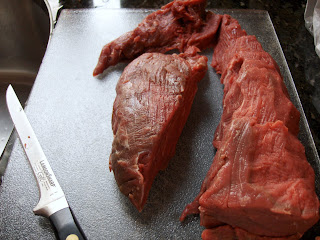Put a steak in it
Unless you have a great relationship with the local butcher or want to pay through the nose for something like a whole tenderloin roast from Lobel's, purchasing a tenderloin and doing the trimming yourself is the best option.
I have seen Alton Brown go to Costco and trim up the huge tenderloins but that is overkill for what we needed. I went down to the local Stop and Shop and purchased 6 pounds of tenderloin. If you are a fan of Cook's Illustrated, you will know that in their taste tests, the Stop and Shop tenderloin beat out all the local as well as national brands including Lobel's and Niman Ranch. The only downside (or upside from my perspective) is that you need to trim it up yourself.
Trimming your own tenderloin has many advantages; 1) you only pay for what you need 2) you can make sure it is trimmed correctly and 3) you can tie the tenderloin up in different thicknesses to facilitate better temperature per your guests liking. Tie one end thinner and it will cook faster then the thicker end and 4) it looks nicer and takes little time.
Most butchers can trim a tenderloin fine but in a grocery store they won't go the extra and needed step of removing the silver from the tenderloin. What they usually do is trim the outside and then tie the silver sides against each other. The tenderloin looks pretty but it has that tough fibrous section running through it. Removing the silver is an important step in prepping the tenderloin and should not be skipped at all. if you do not know how to trim a tenderloin it is pretty simple to do, but I won't walk you through all the steps here.
Basically you need a few things; 1) a wicked sharp fillet knife 2) paper towels 3) butcher twine. Trim away any of the fat you do not like, make sure you flip the meat around and hunt out all the little bits. Remember that you are paying a lot for this beef and just trim away the fat only. When it comes to the silver you should see a silver band that runs down the back.
Because my hands were pretty gross at this point I did not take a photo but I found this one on the web. The method that I use is to use my knife to pull up one section then hold the meat with one paper towel and hold the tip of the silver with another paper towel. This way I can pull the silver right off the tenderloin with out using the knife. Also, I would never use a knife on a metal surface. They should of put a cutting board inside the sheet rather then cutting on the metal.
You can see from the various shapes that there is a natural sort of Lego fit to everything.
I sprayed the tenderloin with Pam and then generously rubbed with fresh ground peeper and salt. I wrapped the tenderloin up in plastic wrap and rolled it to make sure it was all evenly covered. This went into a pre-heated oven at 375 for about 25 minutes or until the thickest part reached 120 degrees internally.








No comments:
Post a Comment